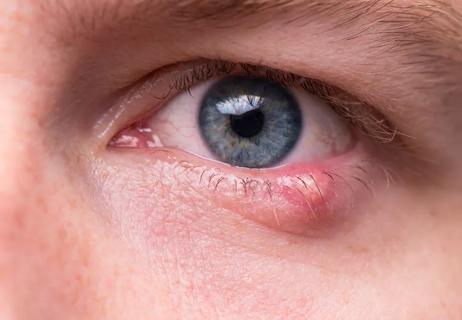Doing so can cause a severe infection, damage to your eyelid or even a corneal abrasion

Oh my, you’ve got a stye.
Advertisement
Cleveland Clinic is a non-profit academic medical center. Advertising on our site helps support our mission. We do not endorse non-Cleveland Clinic products or services. Policy
Regardless of how you got the stye — maybe you rubbed your eyes with dirty hands, used expired or contaminated cosmetics or shared eye makeup — you’re now left with a painful red bump on the edge of your eyelid.
“A stye forms when bacteria enter the oil glands in the eyelids. This leads to inflammation, as well as the formation of a painful lump,” explains family physician Matthew Goldman, MD. “Also known as a hordeolum, a stye is typically caused specifically by Staphylococcus aureus bacteria.”
In addition to pain and discomfort, a stye can literally be an eyesore, making you want to do everything you can do to get rid of it.
So, should you pop a stye? While there are a variety of home remedies you can use to alleviate symptoms, like crusting along the eyelid — you should think twice before you attempt popping your stye.
Dr. Goldman explains why popping a stye isn’t such a good idea and what you should do instead.
Don’t give in to your temptation to pop a stye, urges Dr. Goldman.
“It’s best to avoid squeezing and/or attempting to pop a stye on your own due to potential risks and complications,” he says.
And while it may not be the answer you were hoping for, if you sit tight and try other home remedies, like applying a warm compress, you’ll more than likely see results soon.
Advertisement
“A stye will usually resolve within one to two weeks with proper home care,” says Dr. Goldman. “The exact amount of time for healing can vary depending on the severity of the stye and the individual.”
Styes are very common, affecting all races, sexes and ages — though adults are more prone to blockage.
But what happens if you do pop a stye? Though it may be tempting to pop a stye, doing so comes with potential risks like:
You also want to refrain from rubbing or touching your eyelid and avoid wearing makeup or contact lenses until the stye has gone away.
Try the following remedies to alleviate symptoms and encourage healing instead of attempting to squeeze and/or pop a stye:
If a stye persists and forms a noninfectious lump caused by blockage and inflammation of an oil gland called a chalazion, surgical drainage may be considered. But surgery is rarely necessary.
“Consider seeing a healthcare provider if a stye doesn’t improve within one to two weeks with home remedies, becomes extremely painful or affects your vision, is a recurrent issue and/or you develop fever or experience any concerning symptoms,” advises Dr. Goldman.
Advertisement
Learn more about our editorial process.
Advertisement

Keep your eyes clean and try to stay makeup- and contacts-free

Most recommended precautions center around minimizing bruising or swelling

Even one drink can have an impact on your cognitive function leading to slurred speech, blurred vision and impaired memory

Understand who may (and may not) benefit

Lorem ipsum dolor sit amet. Et odio Quis vel ipsam omnis eum alias deleniti et placeat impedit non voluptas galisum hic autem enim et cupiditate aliquid. Est beatae quidem non facilis autem ut commodi nisi aut tempore rerum et dolores voluptatem cum enim optio id sapiente quasi. Ad laboriosam officiis 33 cupiditate sequi ea voluptatum consectetur qui necessitatibus voluptate et quasi doloremque et facere explicabo quo explicabo officia

Seeking help through therapy can be an important step in improving your quality of life when you have UC

Type 2 diabetes isn’t inevitable with these dietary changes

Applying a hot or cold compress can help with pain